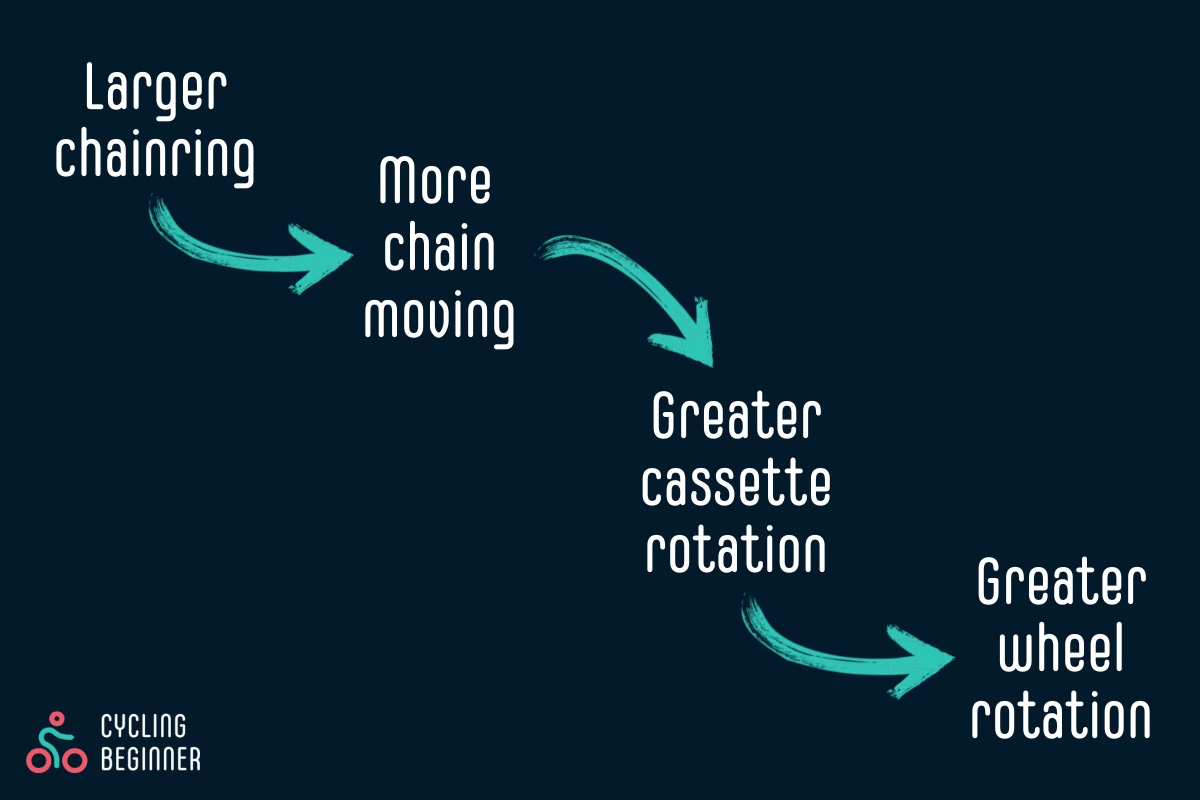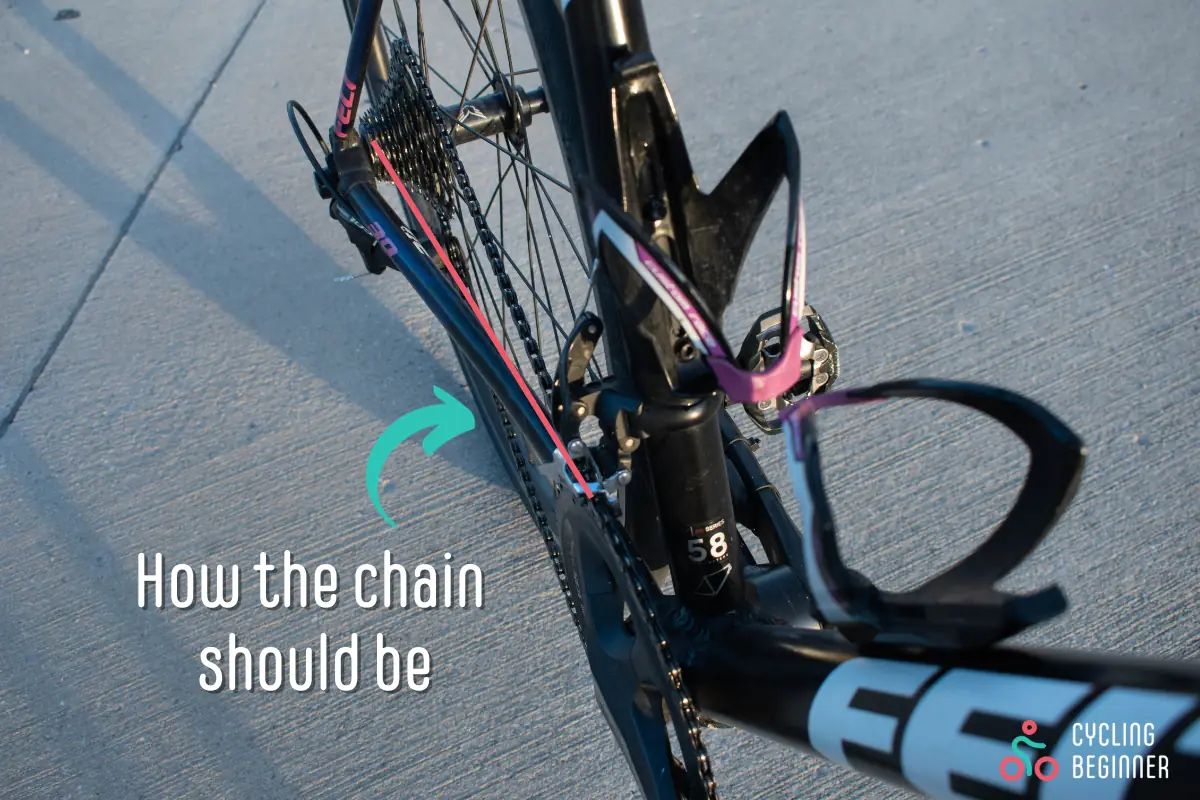Most of the time, cyclists just ride their bikes, happily shifting between gears and never questioning how the gears work. Why is it so much harder to pedal with a chain on a small cog than a larger one?
The gears change the ratio between the size of the used cassette cog and the chainring. The smaller the rear cog, the less crank rotation is needed for one cog revolution, but it requires more power. The story is reversed on a larger cog, where each rotation requires less power.
The functioning of gears is quite simple once we understand the logic or physics behind it. I will try to explain it as simply as possible below.
What affects the difficulty of pedaling?
Before we delve into the details of gear ratios and how they work, we need to understand which parts of the bike are involved in pedaling and moving the bike.
- Crank. Connected to the pedal. By pushing on the pedals, we turn the crank, which turns the chainring.
- Chainring. Connected to the crank. By turning the pedals, we rotate the chainring and, ultimately, the chain, which transmits our work to the rear cog. On road bikes, you will usually find two chainrings – a larger one and a smaller one.
- Cassette. Fitted to the rear wheel. It’s rotated by the chain, which results in rear wheel rotation. Road bikes usually use cassettes with 9 to 12 cogs.
- Chain. Connects the chainring and cassette. It transfers the power produced by the cyclist from the chainring to the cassette.
These four bike parts are crucial when we talk about gear ratios. By shifting, you’re changing the ratio between the crankset’s rotation and the rear wheel’s rotation. The higher the ratio, the harder it is to pedal, but the faster you can go.
Why is it harder to pedal on a small rear cog?
When we start talking about gear ratios, we quickly realize that by shifting, we are changing the ratio between the size of the cassette and the chainring.
I don’t know about you, but as a kid, I always wondered why pedaling with the chain on the small cog at the back is not easier than pedaling with the chain on the big cog. ‘Surely it will be easier to turn the small cog than the big one,’ I thought. Oh boy, was I wrong.
A small turn of the pedal for a big turn of the wheel
Let’s focus on the cassette first and ignore what is happening on the chainring. So, we have between 9 and 12 cogs at the back, with the smallest being the hardest to pedal and the largest the easiest.
To understand why this is the case, we need to focus on the relationship between the three parts of the wheel. We want to know how the crank, the cassette and the wheel are related and how the turn of one affects the other.
- The relationship between the cassette and the wheel. One revolution of the cassette represents one revolution of the wheel. Pretty simple, right?
- The relationship between the crank and the cassette. By shifting, we are changing this relationship. The smaller the cog, the less crank revolution is needed for one full revolution of the cog.
If we know that the gear and the wheel have the same revolution ratio, we only need to look at the other ratio, i.e., the ratio between the crankset and the cassette.
So we want to know how much distance the wheel covers in one crank revolution. The longer the distance, the more efficient our pedaling becomes, but it also becomes more difficult.
Riding in a higher gear gives you the potential for higher speeds but at the cost of greater effort.
Let’s simplify it a bit more.
If we pedal on the smallest cog, then with each crank revolution, the wheel does 3.25 revolutions. Converted into actual distance, we travel 6.85 meters (7.5 yards) with one crank turn.

Now, shift the chain to the largest cog. We immediately notice that pedaling is easier, but this results in less distance traveled. Each crank revolution results in only 1.2 turns of the wheel or 2.53 meters (2.7 yards) of distance covered.

When the cog is larger the crank turns more easily, but the distance covered is much shorter.
I only understood how the gears worked when I applied the concept to one of my everyday situations. Perhaps an example will help you too.
Imagine you have come home from the grocery store and have a trunk full of stuff you need to take to your house. You are faced with a decision:
You can try to carry it all in one go, but it will take a lot of effort.
OR
You can take the stuff from the car to the flat in several rounds, each requiring less effort.
At the end of the day, you have done the same amount of work — you have brought all the stuff to the house. The only difference was the method and distribution of the work.
The same goes for gears. You can cover the same distance with one turn of the crank or with multiple turns. The only difference is how much effort each turn will require.
Why do we ride uphill in a lower gear?
The rider’s task is to find the right ratio between the difficulty of the crank turn and the distance traveled per crank turn:
- On the flat, a moderate effort per crank revolution is fine, and we settle for a medium distance traveled.
- On descents, the crank turn is easier due to the effect of gravity, so we can afford to pedal in a higher gear and consequently cover the distance faster.
- On a climb, gravity works in the opposite direction of our movement. Cyclists make a compromise here, choosing to do less work more often and settle for less distance traveled with each turn of the crankset.
I must point out that on flat terrain, and especially on descents, inertia also helps the rider. After you stop pedaling, you don’t immediately stop but keep going for a while at the expense of the work you have done before.
But on a climb, gravity is working against us, counteracting the effect of inertia. The work invested is translated into distance traveled almost in the 1:1 ratio. We stop almost immediately after we stop pedaling.
We move forward purely based on the work we have invested. Therefore, cyclists prefer to divide the work into smaller chunks and use a lower gear to overcome the required effort.
Why is it harder to pedal on a larger chainring?
Just when you think you understand how gears work, the chainring comes into play. On road bikes, there are usually two sizes with different numbers of teeth.
Here, the situation differs from the cassette, with the larger chainring representing a higher gear. Let’s take a look at why this is so.
A larger chainring has more teeth than a smaller one (who would have thought, right?). We know that each chain link is in contact with one chainring tooth, meaning we move a larger part of the chain if we rotate a larger chainring. If we move a larger part of the chain, we rotate the cassette more, leading to greater wheel rotation.

Let me give you a concrete example that will make it a little easier to understand how the chainring works and interacts with the cassette.
Let’s say we have a 50-tooth chainring at the front and a 25-tooth cog at the rear. Each turn of the chainring will result in two turns of the cassette. That translates to two revolutions of the wheel.
Now we change the chainring and use a 25-tooth one (this type of chainring is not very common, but it will make it easier to understand gearing). At the rear, we still have a 25-tooth cog. In this case, one turn of the chainring means exactly one cassette revolution.
The efficiency of chainring rotation is reduced. One full turn covers a shorter distance, but it is easier to make this revolution. The same laws that we have already learnt with the cassette apply again.
Why isn’t the smallest cog on the same side at the front and rear?
Looking at the bike, particularly the gears, you will quickly notice that the sprockets are oriented differently at the front and rear.
At the rear, the smallest cog is furthest from the bike, while at the front, the smaller cog is closer to the bike.
Why is this?
This orientation of the sprockets ensures that there is no ‘cross-chaining’ when riding in the highest or lowest gear. This orientation reduces occurrences when the chain runs diagonally between the chainring and the cassette, which prolongs its lifespan.

The existing cog arrangement ensures the chain is aligned when riding in the lowest gear. It is on the largest cassette sprocket, right next to the wheel, and on the smallest chainring, also right next to the wheel. Perfectly aligned as it should be.
When riding in the highest gear, the story is reversed, and the chain is on the smallest cog at the rear and the largest cog at the front, both of which are furthest from the bike. This way, the chain is aligned again.
Even with this cog arrangement, ‘cross-chaining’ can still occur, but it is the cyclist’s job to prevent it. It is not advisable to ride with the chain on the large chainring and the large cog at the rear, and vice versa. The rider must shift from the larger to the smaller chainring in time.
Conclusion
The gearing is, at first glance, quite complicated. But when you delve into the physics behind it, you quickly understand why turning a smaller cog is harder than turning a larger one.
By riding on the smaller cog, we enable ourselves to turn the cog, and therefore the tire, several times with each turn of the crank. This results in a longer distance traveled in a single crank turn but requires more power.
On the other hand, riding with the chain on the larger cog makes it easier to turn the crank, but we cover a shorter distance in one revolution.
At the front, the story is reversed. One turn of the larger chainring moves the chain more, which results in more cassette turns. And more cassette turns mean a longer distance traveled. But this requires more power.
A turn of the smaller chainring moves the chain less and consequently turns the rear cog less. This leads to a shorter distance traveled per revolution, but you need much less power to rotate it.
Finally, it’s good to know why the front and rear sprockets are orientated differently. This ensures the chain does not cross and consequently stretch when riding in the lowest or highest gear. This arrangement of the sprockets indirectly extends the lifespan of the chain.

